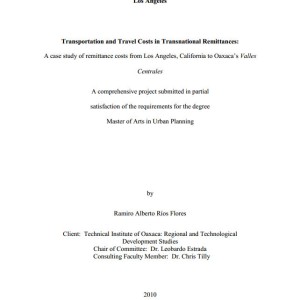
Authors: Ramiro Rios Flores
Date: January 1, 2010
Project: [wpv-post-link id=”$project”]
The purpose of this study is to identify and quantify transportation and travel costs incurred by families who send remittances from Los Angeles to the central valley of Oaxaca, and based on the results, the study proposes potential solutions to reduce the costs associated with sending remittances using cell phone technology known as branchless banking. Currently, most literature on remittance costs has focused on research concerning transaction and foreign exchange costs and explaining how responsive customers are to the change in price of sending a remittance. Although the price of remitting money, namely transaction and foreign exchange cost, (TrC+FxC) is an important determinant of how much and how often people send money to their families, it is only part of the total cost of a remittance transaction. To understand costs better it is important to analyze travel and transportation costs involved while sending and receiving a remittance. Many bi-national families are aware of these costs, and it affects the decision making process of how often, how much, where, and how to send remittances. Generally, people who send remittances to Oaxaca belong to low income families both in the United States and México. Reducing costs for sending money would mean that these families would be able to keep a higher percentage of the face value of the transfer, thus increasing their incomes, and as a consequence; their purchasing power over time.
Link to Publication